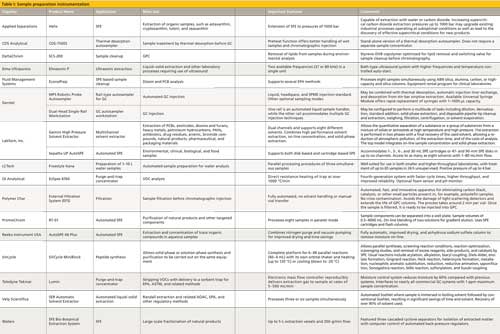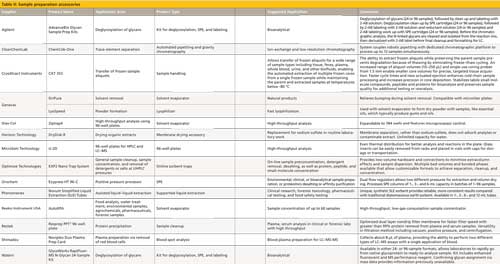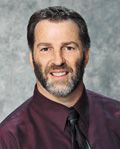New Sample Preparation Products and Accessories for 2016
LCGC North America
This yearly report on new products introduced at Pittcon or in the preceding year covers sample preparation instruments.
This yearly report on new products introduced at Pittcon or in the preceding year covers instruments, accessories, and sorbents for sample preparation.
Our annual review of sample preparation products covers new product introductions made since May 2015. The primary focus is new product introductions at Pittcon, though this is not the exclusive focus. In late 2015, the LCGC editorial staff submitted a survey to vendors of sample preparation products. Responses to this survey are compiled in this review. Additionally, a keyword search using the terms “sample preparation” and “extraction” was conducted for exhibitors at Pittcon 2016; then each of these vendors was visited. Although attempts were made to be as inclusive as possible, we apologize for any oversight.
While attendance at Pittcon has fallen over the past decade and some vendors have diminished their presence, the current product review demonstrates the importance of regularly attending such conferences to stay up to date with the latest instrumentation. Although there were no monumental splashes of new technology, when taken as a whole, the incremental advances developed over the past year add up to significant progress in the field of chromatographic sample preparation.
In last year’s product review (1), we forecast advances in sorbent technology, including QuEChERS (quick, easy, cheap, effective, rugged, and safe); activity around the end of the original solid-phase microextraction (SPME) patents, including biocompatible and liquid chromatography (LC)-compatible products; and serial and parallel sample processing, all driven by bioanalytical and food safety applications. Meanwhile, our recent survey of sample preparation trends (2) added interest in derivatization, pressurized solvent extraction (PSE), solvent evaporation, homogenization, internal standard addition, trace enrichment, matrix-solid phase dispersion (MSPD), microwave-assisted extraction (MAE), solvent exchange, supercritical fluid extraction (SFE), ultrasound extraction, stir-bar sorptive extraction (SBSE), restricted-access media (RAM), and direct analysis in real time (DART) mass spectrometry (MS).
Our batting average with these prognostications isn’t too bad. Excluding applications (of which there are several significant recent publications in many of the areas described above), product introductions in the past year touched on sorbent technologies (including solid-phase extraction [SPE], MSPD, and QuEChERS); solvent evaporators and the associated trace enrichment and solvent exchange; serial and parallel processing, especially in SPE; and advanced techniques for extracting solids (including SFE, ultrasound, automated Soxhlet, and PSE). One major driver of advances in sample preparation that we did not anticipate is the buzz (pun intended) around medicinal marijuana.
This review is presented in three sections. First, we discuss advances in instrumentation for sample preparation. This instrumentation is primarily concerned with extracting solid samples, although automated SPE systems are discussed (though sorbent technology is presented elsewhere). Next, we turn to accessories and supporting technologies in the sample preparation process. Advances in sorbents is the final section. To assist readers with some of the details behind these new products, each section includes a table that summarizes the associated products.
Sample Preparation Instrumentation
New instrumentation for sample preparation can be classified into four major areas: automated SPE, enhanced extraction of solids, approaches to volatile samples, and specialty products. These are summarized in
Table I.
CLICK TABLE TO ENLARGE

CLICK TABLE TO ENLARGE
IF TABLE IS STILL TOO SMALL, CLICK ONCE MORE AND IT WILL ENLARGE FURTHER
Automated Solid-Phase Extraction
As we discussed in our trends survey (2), automation, including serial and parallel sample processing, is of strong interest to those working in the laboratory. Four instruments centered on automated SPE appeared this year. PromoChrom introduced the RT-01 system, LabTech had the Sepaths UP system, Reeko Instruments announced the Auto SPE-60 Plus system, and Fluid Management Systems presented the EconoPrep system. These systems are primarily in response to demand from the environmental and bioanalytical communities. A detailed look at the products shows parallel processing appears to be the norm, a wide range of solvent volumes and solvent switching is available, and both the disk and cartridge approaches to SPE are accommodated. For specific applications, the systems may be associated with specific SPE products. One criticism with automation and instrumentation in general is the associated acquisition cost. Fluid Management Systems announced a rental program aimed at getting clinical laboratories into the automated SPE field. Although equipment rental programs are not new, they are also not commonplace. It will be interesting to see if this program targeting clinical laboratories will gain traction.
While not automated SPE, Gerstel introduced two products coupling robotic automation (via their gas chromatography [GC] autosampler platform) with GC injection. Regarding analyte isolation, these systems have liquid sampling, headspace sampling, SPME, and SBSE capabilities. For sample treatment, capabilities are as varied as derivatization, internal standard addition, weighing, and solvent evaporation. Additionally, a new module accommodates ease of replacing injection syringes.
Enhanced Extraction of Solids
The application of heat or energy to enhance extraction efficiency beyond that observed with Soxhlet extraction has been of interest for the past generation. Perhaps the most straightforward approach is what has been termed automated Soxhlet or the Randall method. This approach combines leaching approached by immersing the sample thimble into the boiling solvent, then the more conventional Soxhlet approach is used to wash the sample. Velp Scientifica introduced such a system this year that also features recovery of the extraction solvent. This approach uses much less solvent and takes significantly less time than conventional Soxhlet.
The next conceptual advance in extraction of solids is the application of pressure so that temperatures greater than the atmospheric boiling point can be used. This pressure may be applied, as in PSE, or via heating a solvent in a closed system, as in MAE or hot-block approaches. The Gemini High Pressure Solvent Extractor system uses both high pressure and high temperature and may be integrated with extract concentration or SPE. The application of ultrasound energy to influence extraction efficiency is well-established. Bath-type sonicators tend to be lower energy, so ultrasonic probes (horns) are often used in extraction. Elmasonic has developed a bath-type ultrasound system with higher frequencies, up to 80 kHz.
A final approach to extracting solids is SFE. The environmental, and other, benefits of supercritical carbon dioxide abound. Extractions at greater scale than analytical are driven by the isolation of cannabidiol from medicinal marijuana, even in states where medicinal marijuana itself may be illegal. Two analytical instruments, from Waters and Applied Separations, are based on the same technology used at larger scale. The Applied Separations Helix system is also engineered for use with subcritical water, to extend the available solvent polarity range of the extracting fluid. Of course, SFE has myriad applications beyond cannabidiol isolation.
Approaches to Volatile Samples
By the nature of the analyte, these systems are typically directly coupled with GC. CDS Analytical added preheating capabilities to thermal desorption to better accommodate wet samples. Teledyne Tekmar and OI Analytical are two companies already established in purge-and-trap technology, and both extended their product range with an eye toward increased throughput. Finally, as noted, the Gerstel autosampler systems are used for GC systems.
Specialty Products
“Specialty” is not meant to imply small markets, but rather unique applications. For example, water analysis via Environmental Protection Agency (EPA) methods is a huge industry segment. The LC Tech Freestyle Xana system performs parallel extractions of up to 10 L of water. Lipid interferences are important concerns in some analyses. DeltaChrom uses a gel-permeation chromatography (GPC) approach to remove lipids during the analysis of environmental solids. Meanwhile, Polymer Char has an external filtration system for sample clean-up associated with polymer synthesis. Also on the synthesis front, the SiliCycle MiniBlock system is applied to peptide synthesis and screening by including an SPE step.
Sample Preparation Accessories
Summarized in Table II, these accessories include products centered on sample handling, solvent evaporation, and sample treatment.

CLICK TABLE TO ENLARGE
IF TABLE IS STILL TOO SMALL, CLICK ONCE MORE AND IT WILL ENLARGE FURTHER
Sample Handling
Related to sample handling, the ChemCob-One robotic pipetting system is coupled with a gravity-chromatography platform for trace enrichment of analytes. For liquid samples subject to SPE, Orochem presented positive pressure processing for sample handling with SPE. Technology for handling solid samples differs from that for liquids, especially when considering frozen biological samples. CyroXtract developed technology for the sample handling of frozen tissue aliquots while minimizing deleterious freeze–thaw cycles by using temperatures as low as -80 °C.
Solvent Evaporation
Although solvent evaporation is conceptually well known, performance of evaporation while avoiding loss of semivolatiles and accommodating high-throughput analysis is difficult. New systems by Glas-Col and Reeko Instruments address these concerns for environmental analysis (Reeko) or with 96-well plates (Glas-Col). Two products from Horizon Technology consider other important issues with solvent evaporation. One product, DriPure, is used to avoid solvent bumping during the evaporation process. It is also compatible with well-plates. Another Horizon product, LyoSpeed, is used with gummy or oil samples to facilitate dry powder formation during solvent evaporation.
Sample Treatment
Sample treatment approaches are currently addressing biological samples. Notably, deglycosylation reactions are of prime interest. Kits from Agilent and Waters are used to deglycosylate glycans, such as glycoproteins, using a 96-well plate format, sample cleanup by SPE, and derivatization for LC–MS or fluorescence. Removal of proteins via precipitation, in a 96-well plate, is facilitated by a new product from Restek. Meanwhile, the Shimadzu Noviplex product removes red blood cells for plasma analysis by LC–MS-MS. Unique sample cleanup products for ultrahigh-pressure liquid chromatography (UHPLC) were also introduced such as the EXP2 Nano Trap on-line sorbent trap by Optimize Technology and processing 96-well plates by MicroSolv. Finally, Phenomenex has been a leader in the development of supported liquid extraction (SLE) and this continues with the introduction of a new sorbent in the Novum product line that targets clinical and food safety analysis.
Sorbent Products
New sorbent technologies are shown in Table III and address dispersive SPE, SPE cartridges and disks, and 96-well plates. These appear to be driven by interest in bioanalysis and food safety laboratories.

CLICK TABLE TO ENLARGE
IF TABLE IS STILL TOO SMALL, CLICK ONCE MORE AND IT WILL ENLARGE FURTHER
Dispersive SPE
Bulk sorbents for use in QuEChERS and MSPD have seen renewed interest since the advent of QuEChERS. Silica-based sorbents from MilliporeSigma, UCT, and SiliCycle remove chlorophyll from heavily pigmented botanicals (QuE Verde by MilliporeSigma) and extend the useful analyte range (UCT and SiliCycle). Another challenging issue is the removal of lipid matter from fatty samples for trace analysis. Agilent addresses this with a proprietary technology in its Bond Elut Enhanced Matrix Removal-Lipid sorbent.
SPE
Three SPE products are of special interest to bioanalytical laboratories. MilliporeSigma developed the Discovery Glycan SPE cartridge for glycan cleanup using a proprietary sorbent phase. The Waters Oasis-Prime sorbent utilizes the company’s hydrophilic-lipophilic balance (HLB) sorbent technology and notably provides a product with superior water wettability. Hilicon AB reapplied the hydrophilic-interaction chromatography (HILIC)–LC approach for separation of hydrophilic samples to its iSPE product aimed at the purification of glycopeptides, glycans, and hydrophilic metabolites. Other new SPE sorbents demonstrate improvements to reversed-phase separations.
Well Plates
Three new 96-well plate products, from Orochem, Phenomenex, and Wheaton, in addition to those previously mentioned, use reversed-phase or ion-exchange mechanisms individually or in a mixed-mode format for high-throughput biochemistry laboratories.
Specialty Sorbents
Metal scavenging for the removal of particulates and complexes of heavy metals is developed into a high performance liquid chromatography (HPLC) guard column, as well as SPE cartridges, well plates, and pipette tips from SiliCycle. The Abalonase products from UCT present a purified β-glucuronidase formula for enzymatic hydrolysis, especially for drug metabolites.
Conclusion and Future Directions
We have noted that new sample preparation products have been heavily driven by market needs, and that trend is likely to continue in the foreseeable future. The vast array of new products introduced in just the past year requires responsible laboratory managers and scientists to continually stay on top of developing trends.
References
- D.E. Raynie, LCGC North Am.33(5), 306–310 (2015).
- D.E. Raynie, LCGC North Am.34(3), 174–188 (2016).

Douglas E. Raynie
“Sample Prep Perspectives” editor Douglas E. Raynie is an Associate Research Professor at South Dakota State University. His research interests include green chemistry, alternative solvents, sample preparation, high resolution chromatography, and bioprocessing in supercritical fluids. He earned his PhD in 1990 at Brigham Young University under the direction of Milton L. Lee.

Troubleshooting Everywhere! An Assortment of Topics from Pittcon 2025
April 5th 2025In this installment of “LC Troubleshooting,” Dwight Stoll touches on highlights from Pittcon 2025 talks, as well as troubleshooting advice distilled from a lifetime of work in separation science by LCGC Award winner Christopher Pohl.
Study Examines Impact of Zwitterionic Liquid Structures on Volatile Carboxylic Acid Separation in GC
March 28th 2025Iowa State University researchers evaluated imidazolium-based ZILs with sulfonate and triflimide anions to understand the influence of ZILs’ chemical structures on polar analyte separation.
Study Explores Thin-Film Extraction of Biogenic Amines via HPLC-MS/MS
March 27th 2025Scientists from Tabriz University and the University of Tabriz explored cellulose acetate-UiO-66-COOH as an affordable coating sorbent for thin film extraction of biogenic amines from cheese and alcohol-free beverages using HPLC-MS/MS.






